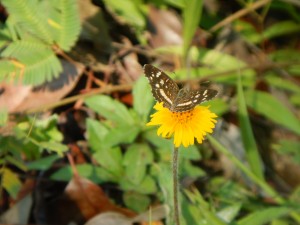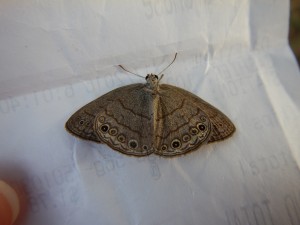This morning we collected our pitfall traps and sorted through all of the samples. In the 16 hours the samples were out, a collective 256 arthropods of over 50 species were caught in our traps. We found ants, beetles, orthopteran, spiders, flies, roaches, and more. Our results showed that there is a greater species abundance and richness on the forest floor than in the canopy. Additionally, in comparing the abundance of arthropods caught in the urine traps versus the abundance of arthropods found in the water traps we found results that suggest a difference in nitrogen needs between the canopy and the floor. The results suggest there is a greater need for nitrogen in the canopy.
By dinner time, I still hadn’t spotted any new Lepidoptera aside from a fuzzy caterpillar that had been close to my pitfall traps. So, once it got dark out I started checking around the building lights for moths. I saw some very interesting looking moths:
- A 4-5 cm orange moth with feathery antenna
- A 2-3 cm brown moth with very cryptic coloring- very pretty [pic below]
- A 2 ish cm orange moth with stripes
- A 3-4 cm brown moth with pale blue splotches
- A 2-3 cm moth that looks like a crumpled leaf
- A 1 cm brown moth with bright yellow markings
- A 1-2 cm black moth
- A 2-3 cm brown moth that was folded up like a little roll
- A 3-4 cm orange/tan moth that had FUZZY LEGS
- A 3-4 cm white moth with black veining
- A 3-4 cm fuzzy white moth
- A 2-3 cm pale green moth

I saw all of these within minutes just by looking by light sources in the dark. Next we went on a night hike. I hadn’t expected to see any Lepidoptera but I actually saw a very large green caterpillar and a white furry(branch-like fuzz) caterpillar. We also saw a huge spider, tarantula, stick bugs larger than my hand, and a hissing cockroach to note a few things. And saw our first venemous snake- a coral snake! It was cool to see the critters of the forest that are usually hiding.



